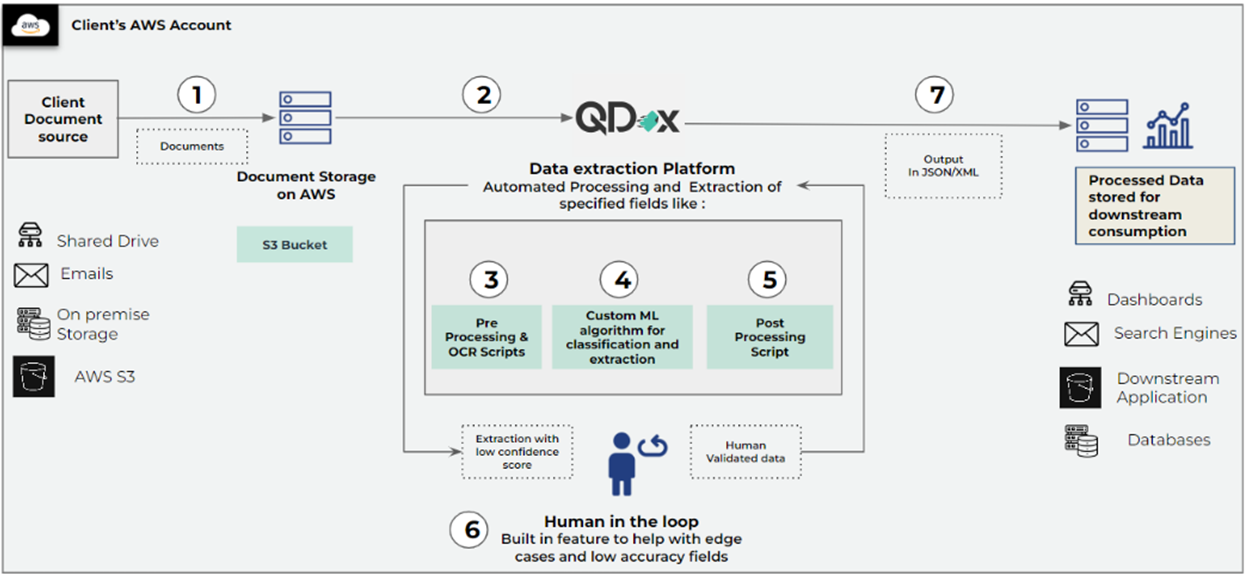AWS Partner Network (APN) Blog
Accelerating Public Health Data Modernization with AI-Powered Document Processing from Quantiphi
By Dawn Heisey-Grove, Leader, SLG HHS Public Health Analytics – AWS
 |
| Quantiphi |
 |
Fifteen years ago, when I worked at a state health department, we had a seven-foot-tall stack of laboratory reports we had received by mail and fax. Every day, over 10 employees completed manual entries to process these backlogged reports. Still, we couldn’t make a dent because the incoming document volume far exceeded our capacity to enter the information.
Fast forward to the current pandemic times. I was not surprised—given everything that’s been shared about chronic underfunding of public health agencies and the need for public health modernization—that public health is still dealing with paper, but magnitudes larger.
Congressional testimony in 2021 indicated that paper-based death certificate filing still happens in some states, which can lead to an eight-week delay in reporting to the U.S. Centers for Disease Control and Prevention (CDC). This slows down the nation’s ability to assess mortality due to a health condition like COVID-19.
Laboratories still fax their test results to public health agencies and frequently change the format of those documents. Laboratory report formats and content can be challenging in the first place, and frequent format changes make automated processing difficult without a solution that learns over time and can quickly adapt to these changes.
One of the first solutions I sought when I joined Amazon Web Services (AWS) was an answer to address public health’s paper problem. Paper—virtual or actual—wasn’t going away. Rural and less technology-savvy organizations lack the ability or resources to automate their reporting infrastructure. Plus, there will always be new forms for the year’s new disease or health concern.
With my introduction to Jim Keller, Quantiphi’s AWS Global CEO, I found a solution for public health. Read on for my interview with Jim about QDox, Quantiphi’s intelligent document processing (IDP) solution that leverages artificial intelligence (AI) to recognize the document type, extract information, and deliver the output in the desired format.
Quantiphi is an AWS Premier Tier Services Partner and AWS Marketplace Seller that’s a category-defining analytics, machine learning, and cloud modernization company.
Q&A with Quantiphi’s Jim Keller
AWS: Jim, can you start us off with a description of QDox? What are some of its key features?
Jim Keller: Quantiphi developed QDox, an AWS-native intelligent document processing solution accelerator. Built with Quantiphi’s machine learning expertise, QDox is a deep learning-based solution capable of comprehending structured, semi-structured, and unstructured documents across various templates.
QDox handles the complexities and nuances of documents received by public health—check out the addendum in this Congressional testimony for one example. This mission-critical document processing solution supports the public health workforce with low IT capacity and high attrition; 1 in 6 public health staff left in the 10 years preceding the pandemic, and 47% plan to retire in the next five years.
Because of its deep learning backend, QDox is far more advanced than the optical character recognition (OCR) of the 1990s and early 2000s. It can convert different types of documents (png, jpg, gif)—printed and handwritten—into searchable PDFs, making it easy to search for specific information. To facilitate that searching, QDox allows for plain language searching to make it easier to gather insights from a volume of documents.
QDox classifies documents based on categories familiar to public health agencies. It extracts information from text fields, tables, checkboxes, and event stamps and signatures. Importantly for public health, QDox includes a “human-in-the-loop” review module that allows for quality control checks and validations of extracted information based on confidence scores assigned by the organization.
AWS: How does QDox enable a document’s journey from ingestion to insights?
Jim Keller: There are multiple stages in a typical QDox workflow, with each adding a layer of human-like document processing.
First, ingestion—bringing the data into QDox for processing. QDox can bring in files from various sources by integrating with an email or FTP/SFTP server, through a bulk upload via an easy-to-use interface or Amazon Simple Storage Service (Amazon S3) bucket, scanning a QR code, or integrating with other information systems or databases.
Next, pre-processing, where documents are rotated, brightened, and skewness to improve extraction accuracy, among other things.
QDox leverages Amazon Textract as the OCR engine to digitize the document and Amazon Comprehend or custom models to classify documents. This is where QDox identifies document types and categorizes them into different datasets for processing.
Once the documents are classified, QDox extracts crucial data points using a custom model trained and tested on the document type. QDox has a human-in-the-loop module for manually reviewing extracted data with a lower confidence score.
Post-processing allows for data enrichment by standardizing the output by converting it into the required format. To ensure continuous improvement, human-corrected information is used to retrain the QDox model to improve its accuracy.
Finally, the extracted output is stored and integrated into a preferred database or enterprise resource planning (ERP) system for use in downstream processes.
AWS: What types of documents can QDox process?
Jim Keller: There aren’t too many constraints on the types of documents QDox can process. It’s mature to onboard new document types seamlessly.
Documents we’ve processed with QDox include laboratory reports, case report forms, chart reviews or other electronic medical records (EMR) reports, surveys, diagnostic and pathology reports, consent forms, certificates, prescriptions sheets, pharmacy bills and receipts, epidemiological information, and claims forms.
Before our current engagement, Quantiphi onboarded new documents in less than a week and began delivering value immediately.
AWS: What measures does QDox employ to ensure security and compliance?
Jim Keller: We recognize that public health agencies are entrusted with significant health information. QDox is mature to onboard public health documents and follows all the necessary data security and governance practices to develop HIPAA-compliant solutions.
Leveraging AWS services, the solution ensures data is encrypted at rest and in transit. Quantiphi’s HITRUST certification is a testimony to our expertise in securing and managing data.
AWS: How do the extracted data accelerate public health decision-making?
Jim Keller: QDox can build a robust data infrastructure and facilitate faster decision-making. Public health measures its speed to decision-making based on the timeliness and completeness of the data it receives.
When we think of it in those terms:
- Improve data timeliness
- By automating the extraction of information from laboratory reports, epidemiologists can more quickly identify patterns in data, such as indications of a cluster or outbreak. This helps public health officials take timely action to prevent or control an outbreak.
- With QDox, public health can have quicker access to data sources currently not readily accessible in a near real-time fashion (for example, birth and death certificates), which allows epidemiologists to link different data sources to understand better the impacts of a disease in a community.
- Improve data completeness
- Rapid ingestion of clinical data from long chart reviews or case report forms means it’s easier for epidemiologists to find critical information about the risk status of individuals. This helps public health officials target their efforts to reach the neediest.
AWS: Could you share an example of QDox used in public health?
Jim Keller: I want to highlight our engagement with the Arkansas Department of Health (ADH), which receives a monthly influx of ~20,000 clinical laboratory reports from different laboratories across the state. The reporting format for each laboratory varies, posing a challenge in extracting information. The varied formats made it difficult to extract the relevant information accurately and delayed the processing of the reports.
To solve the challenges faced by ADH, Quantiphi implemented QDox to:
- Process various types of laboratory reports.
- Automatically classify reports and accurately extract key information, such as laboratory test name and result and sending facility name.
- Reduce manual intervention and the time processing laboratory reports.
- Conduct a human review of low-confidence extraction results via a low-code interface.
AWS: What does the QDox process flow look like? How does it function?
Jim Keller: Here is the QDox process flow that explains how documents from a customer’s storage are processed and how helpful information from that document is extracted in a suitable format.
Figure 1 – QDox process flow diagram.
Process flow description:
- Upstream integration to the QDox platform can be through any custom application, email, fax, Amazon S3 bucket, or SFTP endpoint.
- QDox workflows are triggered once a document enters its S3 bucket.
- Document standardization is performed to improve the document’s quality, including image enhancement and proper alignment.
- A custom machine learning model on top of Amazon Textract enhances the extraction of printed and handwritten text from documents with complex formats. The classification model sorts documents into appropriate categories.
- Post-processing script assigns accurate labels to extracted data based on the organization’s business logic.
- The QDox user interface (UI) provides a no-code, human-in-the-loop mechanism for validating extracted results with a confidence score lower than the organization’s set threshold—specific to a single field or the full form
- Extracted data is stored in a JSON or XML format in a desired location for integration with any downstream application.
Conclusion
QDox can speed public health decision-making by automating data extraction, analysis, and interpretation. This helps public health officials quickly identify patterns in the data and make informed decisions about public health policies and interventions intended to protect the health and well-being of a community.
For more information on QDox, please visit Quantiphi’s website. You can also learn more about QDox in AWS Marketplace.
Quantiphi – AWS Partner Spotlight
Quantiphi is an AWS Competency Partner and AI-first digital engineering company driven by the desire to solve transformational problems at the heart of the business.
Contact Quantiphi | Partner Overview | AWS Marketplace | Case Studies

